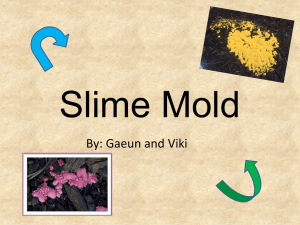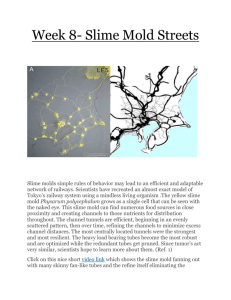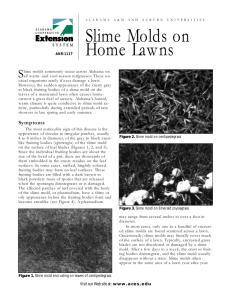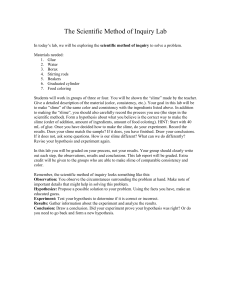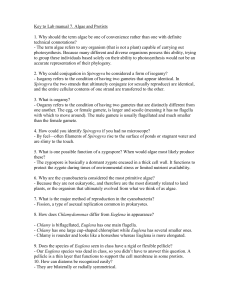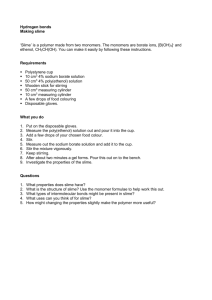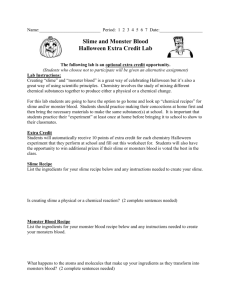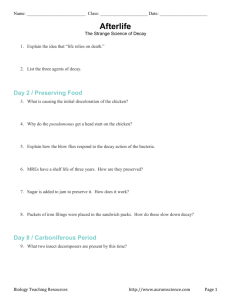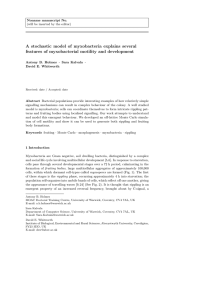Fungus-like Protists – Slime Molds
advertisement
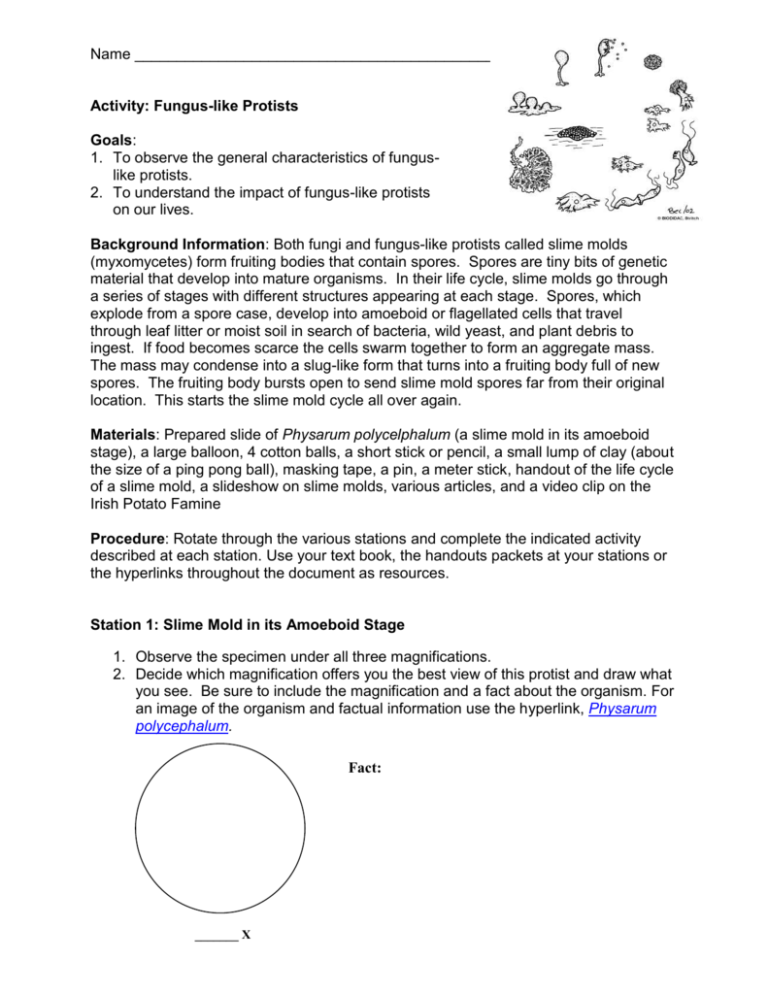
Name ____________________________________________ Activity: Fungus-like Protists Goals: 1. To observe the general characteristics of funguslike protists. 2. To understand the impact of fungus-like protists on our lives. Background Information: Both fungi and fungus-like protists called slime molds (myxomycetes) form fruiting bodies that contain spores. Spores are tiny bits of genetic material that develop into mature organisms. In their life cycle, slime molds go through a series of stages with different structures appearing at each stage. Spores, which explode from a spore case, develop into amoeboid or flagellated cells that travel through leaf litter or moist soil in search of bacteria, wild yeast, and plant debris to ingest. If food becomes scarce the cells swarm together to form an aggregate mass. The mass may condense into a slug-like form that turns into a fruiting body full of new spores. The fruiting body bursts open to send slime mold spores far from their original location. This starts the slime mold cycle all over again. Materials: Prepared slide of Physarum polycelphalum (a slime mold in its amoeboid stage), a large balloon, 4 cotton balls, a short stick or pencil, a small lump of clay (about the size of a ping pong ball), masking tape, a pin, a meter stick, handout of the life cycle of a slime mold, a slideshow on slime molds, various articles, and a video clip on the Irish Potato Famine Procedure: Rotate through the various stations and complete the indicated activity described at each station. Use your text book, the handouts packets at your stations or the hyperlinks throughout the document as resources. Station 1: Slime Mold in its Amoeboid Stage 1. Observe the specimen under all three magnifications. 2. Decide which magnification offers you the best view of this protist and draw what you see. Be sure to include the magnification and a fact about the organism. For an image of the organism and factual information use the hyperlink, Physarum polycephalum. Fact: _______ X Station 2: Exploding Spores 1. Pull apart each cotton ball to make 5 smaller balls of cotton. You should have a total of 20 mini-cotton balls. Be sure to roll the mini-cotton balls to make them a little more compact so they will fly further. 2. Stretch a balloon so that it will inflate easily. 3. Insert the 20 mini-cotton balls through the neck of the balloon. 4. Carefully blow up the balloon with the cotton balls inside and knot it at the end. 5. Tape the knotted end to the top of a pencil. Try to tape the balloon so that it stands upright. 6. Roll the clay into a ball. Push the flat end of the pencil into the clay ball and flatten the bottom so that the whole assembly will stand upright. 7. Draw a labeled illustration of your fruiting body model. Label the cotton ball spores inside. The balloon is the spore case. The stick is the stalk. 8. Place the fruiting body model on the floor in a location directed by your teacher. 9. When your whole team has assembled around the model have one person jab it with a pin and observe how far your “spores” travel. Measure the distance of the farthest “spore” from your set-up in centimeters or meters. 10. Hyperlink: Fruiting Body Diagram Complete the following: a. Draw a labeled illustration of your fruiting body model. The fruiting body includes the spore case filled with the spores, and the stalk. The pieces of cotton balls are the spores. The balloon is the spore case. The stick is the stalk. b. What happened when your fruiting body exploded? c. Record the distance of the farthest “spore” from your set-up in centimeters or meters. c. Based on your observations of the punctured fruiting body model, explain the function of actual slime mold fruiting bodies. d. Explain why the function of the fruiting body is important to the slime mold’s survival. Station 3: Slime Mold Slideshow 1. Open PowerPoint > groups on homeshare > all students > slime mold PPT. 2. View the slideshow about slime molds and answer the following questions: a. What makes up the body of a slime-mold? b. What are some ways spores from fruiting bodies can be dispersed? Station 4: Slime Mold Article 1. Read the article Introduction to the “Slime Molds.” 2. Answer the following questions in complete sentences: a. Describe a plasmodial slime mold. b. What are the three main groups of slime molds? c. What are sporangia? Station 5: Video Clip: Irish Potato Famine 1. Watch the video clip describing the Irish Potato Famine and read the handout about water molds. 2. Answer the following questions based on the handout and the video clip. a. What happened in 1845 to Ireland’s potato harvest? b. What organism caused the famine called the “great hunger?” c. Why was the potato crop so important to the Irish peasants? d. How do you think this impacted the U.S. population shortly after 1845? Note: If the video is not available read use the following hyperlink, Irish Potato Famine. Station 6: Life Cycle of a Slime Mold 1. Read the article about the life cycle of a slime mold. 2. Match the descriptions with the labels on the drawing of the life cycle. C D B A ______ Spores explode from a fruiting body spore case. _____ Each spore develops into an amoeboid or flagellated cell. _____ If the food supply is scarce, individual cells swarm together to form an aggregate or multicellular mass. _____ The mass condenses to form a slug-like structure and grows upward into a fruiting body.
